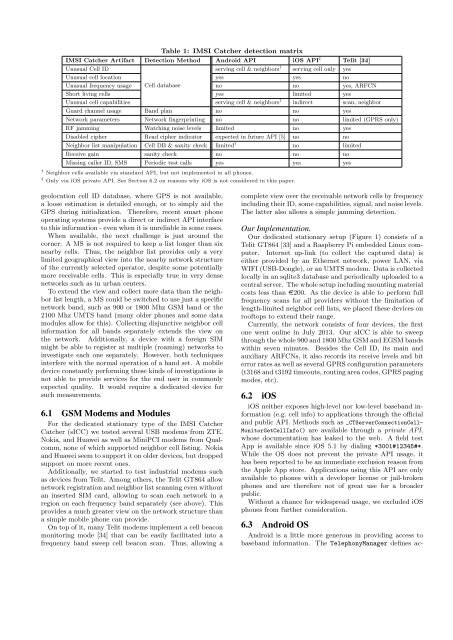AdrianDabrowski-IMSI-Catcher-Catcher-ACSAC2014-preprint-20140820
AdrianDabrowski-IMSI-Catcher-Catcher-ACSAC2014-preprint-20140820
AdrianDabrowski-IMSI-Catcher-Catcher-ACSAC2014-preprint-20140820
You also want an ePaper? Increase the reach of your titles
YUMPU automatically turns print PDFs into web optimized ePapers that Google loves.
Table 1: <strong>IMSI</strong> <strong>Catcher</strong> detection matrix<br />
<strong>IMSI</strong> <strong>Catcher</strong> Artifact Detection Method Android API iOS API ‡ Telit [34]<br />
Unusual Cell ID<br />
serving cell & neighbors † serving cell only yes<br />
Unusual cell location yes yes no<br />
Unusual frequency usage Cell database<br />
no no yes, ARFCN<br />
Short living cells yes limited yes<br />
Unusual cell capabilities serving cell & neighbors † indirect scan, neighbor<br />
Guard channel usage Band plan no no yes<br />
Network parameters Network fingerprinting no no limited (GPRS only)<br />
RF jamming Watching noise levels limited no yes<br />
Disabled cipher Read cipher indicator expected in future API [5] no no<br />
Neighbor list manipulation Cell DB & sanity check limited † no limited<br />
Receive gain sanity check no no no<br />
Missing caller ID, SMS Periodic test calls yes yes yes<br />
† Neighbor cells available via standard API, but not implemented in all phones.<br />
‡ Only via iOS private API. See Section 6.2 on reasons why iOS is not considered in this paper.<br />
geolocation cell ID database, where GPS is not available,<br />
a loose estimation is detailed enough, or to simply aid the<br />
GPS during initialization. Therefore, recent smart phone<br />
operating systems provide a direct or indirect API interface<br />
to this information - even when it is unreliable in some cases.<br />
When available, the next challenge is just around the<br />
corner: A MS is not required to keep a list longer than six<br />
nearby cells. Thus, the neighbor list provides only a very<br />
limited geographical view into the nearby network structure<br />
of the currently selected operator, despite some potentially<br />
more receivable cells. This is especially true in very dense<br />
networks such as in urban centers.<br />
To extend the view and collect more data than the neighbor<br />
list length, a MS could be switched to use just a specific<br />
network band, such as 900 or 1800 Mhz GSM band or the<br />
2100 Mhz UMTS band (many older phones and some data<br />
modules allow for this). Collecting disjunctive neighbor cell<br />
information for all bands separately extends the view on<br />
the network. Additionally, a device with a foreign SIM<br />
might be able to register at multiple (roaming) networks to<br />
investigate each one separately. However, both techniques<br />
interfere with the normal operation of a hand set. A mobile<br />
device constantly performing these kinds of investigations is<br />
not able to provide services for the end user in commonly<br />
expected quality. It would require a dedicated device for<br />
such measurements.<br />
6.1 GSM Modems and Modules<br />
For the dedicated stationary type of the <strong>IMSI</strong> <strong>Catcher</strong><br />
<strong>Catcher</strong> (sICC) we tested several USB modems from ZTE,<br />
Nokia, and Huawei as well as MiniPCI modems from Qualcomm,<br />
none of which supported neighbor cell listing. Nokia<br />
and Huawei seem to support it on older devices, but dropped<br />
support on more recent ones.<br />
Additionally, we started to test industrial modems such<br />
as devices from Telit. Among others, the Telit GT864 allow<br />
network registration and neighbor list scanning even without<br />
an inserted SIM card, allowing to scan each network in a<br />
region on each frequency band separately (see above). This<br />
provides a much greater view on the network structure than<br />
a simple mobile phone can provide.<br />
On top of it, many Telit modems implement a cell beacon<br />
monitoring mode [34] that can be easily facilitated into a<br />
frequency band sweep cell beacon scan. Thus, allowing a<br />
complete view over the receivable network cells by frequency<br />
including their ID, some capabilities, signal, and noise levels.<br />
The latter also allows a simple jamming detection.<br />
Our Implementation.<br />
Our dedicated stationary setup (Figure 1) consists of a<br />
Telit GT864 [33] and a Raspberry Pi embedded Linux computer.<br />
Internet up-link (to collect the captured data) is<br />
either provided by an Ethernet network, power LAN, via<br />
WIFI (USB-Dongle), or an UMTS modem. Data is collected<br />
locally in an sqlite3 database and periodically uploaded to a<br />
central server. The whole setup including mounting material<br />
costs less than e200. As the device is able to perform full<br />
frequency scans for all providers without the limitation of<br />
length-limited neighbor cell lists, we placed these devices on<br />
rooftops to extend their range.<br />
Currently, the network consists of four devices, the first<br />
one went online in July 2013. Our sICC is able to sweep<br />
through the whole 900 and 1800 Mhz GSM and EGSM bands<br />
within seven minutes. Besides the Cell ID, its main and<br />
auxiliary ARFCNs, it also records its receive levels and bit<br />
error rates as well as several GPRS configuration parameters<br />
(t3168 and t3192 timeouts, routing area codes, GPRS paging<br />
modes, etc).<br />
6.2 iOS<br />
iOS neither exposes high-level nor low-level baseband information<br />
(e.g. cell info) to applications through the official<br />
and public API. Methods such as _CTServerConnectionCell-<br />
MonitorGetCellInfo() are available through a private API,<br />
whose documentation has leaked to the web. A field test<br />
App is available since iOS 5.1 by dialing *3001#12345#*.<br />
While the OS does not prevent the private API usage, it<br />
has been reported to be an immediate exclusion reason from<br />
the Apple App store. Applications using this API are only<br />
available to phones with a developer license or jail-broken<br />
phones and are therefore not of great use for a broader<br />
public.<br />
Without a chance for widespread usage, we excluded iOS<br />
phones from further consideration.<br />
6.3 Android OS<br />
Android is a little more generous in providing access to<br />
baseband information. The TelephonyManager defines ac-



